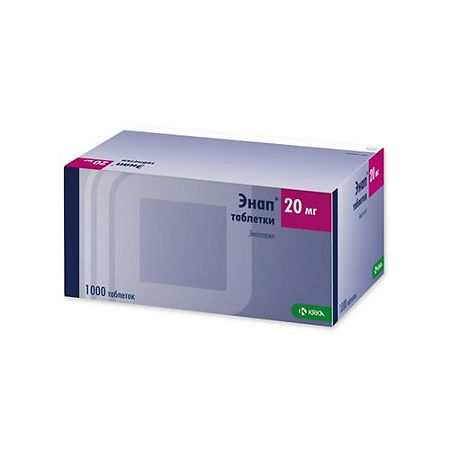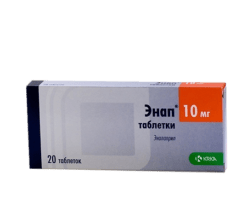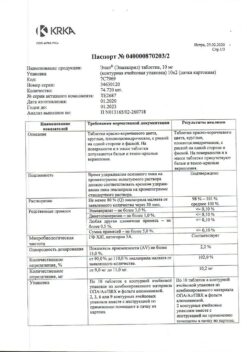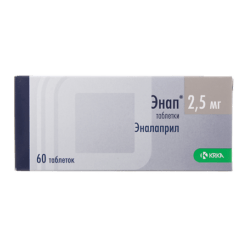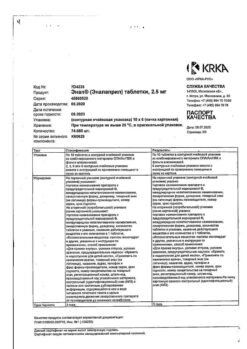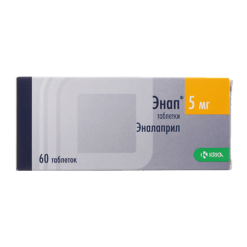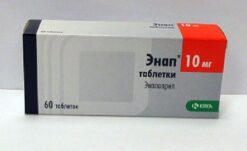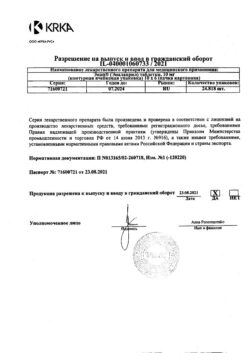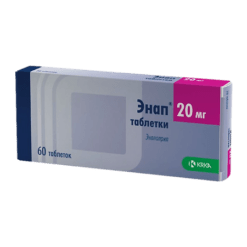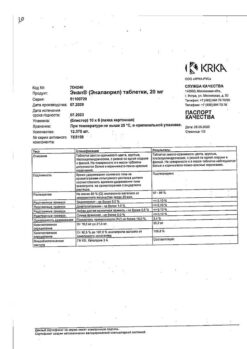No products in the cart.
Enap, 20 mg tablets, 1000 pcs.
€1.00
Out of stock
(E-mail when Stock is available)
Description
Enap is an antihypertensive drug, the mechanism of action of which is associated with inhibition of angiotensin-converting enzyme activity, resulting in reduction of angiotensin-II formation.
Enalapril is a “prodrug”: as a result of its hydrolysis enalaprilate is formed, which inhibits ACE. Its mechanism of action is related to the reduction of angiotensin I formation from angiotensin II, the reduction of which leads to a direct reduction of aldosterone secretion. This decreases total peripheral vascular resistance, systolic and diastolic blood pressure (BP), post- and preload on myocardium.
Dilates the arteries to a greater extent than the veins, and there is no reflex increase in heart rate.
Hypotensive effect is more pronounced at high plasma renin levels than at normal or reduced levels. Reduction of blood pressure (BP) within therapeutic limits has no effect on the cerebral blood flow, blood flow in the brain vessels is maintained at a sufficient level even against the background of reduced blood pressure. It increases coronary and renal blood flow.
Long-term use reduces left ventricular myocardial hypertrophy and arterial wall myocytes resistive type, prevents the progression of heart failure and slows the development of left ventricular dilatation. Improves blood supply to ischemic myocardium. Reduces platelet aggregation.
It has some diuretic effect.
The time of onset of hypotensive effect when taken orally is 1 hour, reaches a maximum after 4-6 hours and lasts up to 24 hours. In some patients, therapy for several weeks is necessary to achieve optimal blood pressure levels. In cardiac insufficiency noticeable clinical effect is observed with long-term use – 6 months or more.
Indications
Indications
– Arterial hypertension.
– Chronic heart failure (as part of the combined therapy).
– Asymptomatic left ventricular dysfunction (as part of combined therapy).
Active ingredient
Active ingredient
Composition
Composition
1 tablet contains:
Enalapril maleate 20 mg.
Auxiliary substances:
Lactose monohydrate,
hydroxypropylcellulose,
corn starch,
sodium bicarbonate,
talk,
Magnesium stearate.
How to take, the dosage
How to take, the dosage
The tablets should be taken orally with a small amount of liquid. The tablets can be taken before, during, or after meals. You should get into the habit of taking the medicine regularly and at the same time.
If a patient misses a dose, take the medication as soon as possible, but not if several hours remain before the next dose. Only the next dose should be taken in this case and not the missed dose. Doses should never be doubled.
The treatment of Enap requires regular medical examinations, especially at the beginning of treatment and/or when determining the most appropriate dose of the drug. The frequency of medical examinations is determined by the attending physician. The dose of the drug is always adjusted according to the patient’s condition.
The treatment of arterial hypertension: The recommended initial dose is 5 mg once daily. After the initial dose, patients should be under medical supervision for 2 hours and an additional 1 hour until blood pressure stabilizes. Dose adjustment depends on achieving therapeutic effect (blood pressure reduction) and if there is no clinical effect, increase by 5 mg after 1-2 weeks. Usually the maintenance dose is 10 to 20 mg, if necessary and if tolerated well enough, the dose can be increased to 40 mg per day. The maximum daily dose is 40 mg. At higher doses it is advisable to divide it into 2 doses.
The treatment of arterial hypertension in special clinical cases:The initial dose for patients who have failed to interrupt diuretics before starting Enap treatment is 2.5 mg as a single dose. For patients with hyponatremia (concentration of sodium ions in serum less than 130 mmol/l) or creatinine concentration in serum more than 0.14 mmol/l the initial dose is 2.5 mg once daily. In elderly patients a more pronounced hypotensive effect and prolongation of the drug action time are more often observed, which is associated with decreased elimination rate of enalapril, so the recommended starting dose in elderly patients is 1.25 mg.
Treatment of congestive heart failure: The recommended starting dose is 2.5 mg once daily. The dose of Enap should be increased gradually until maximum clinical effect is achieved, usually after 2 to 4 weeks. The usual maintenance dose is 2.5 mg to 10 mg as a single dose; the maximum maintenance dose is 20 mg twice daily.
Treatment of asymptomatic left ventricular dysfunction:The recommended starting dose is 2.5 mg twice daily; some dose adjustment depends on patient tolerance. Usually the maintenance dose is 10 mg twice a day.
Treatment of arterial hypertension in renal diseases: Enap dose is determined depending on renal function and/or creatinine clearance values. For patients with creatinine clearance more than 0.5 ml/s (30 ml/min) the initial dose is 5 mg per day. For patients with creatinine clearance less than 0.5 ml/sec (30 ml/min) the initial dose is 2.5 mg per day and is gradually increased until clinical effect is achieved.
Treatment of patients on hemodialysis: for patients on the day of hemodialysis – 2.5 mg; on other days the physician adjusts the dose according to the blood pressure readings.
Treatment with Enap is long-term, usually lifelong, unless circumstances arise that require its withdrawal.
Interaction
Interaction
The patient should refrain from drinking alcoholic beverages because ethanol increases the reduction of blood pressure (BP) with enalapril.
Simultaneous use of enalapril and diuretics or other hypotensive agents increases the effectiveness of these drugs.
Interaction with drugs used to treat heart failure (cardiac glycosides) is of no clinical significance.
Before surgical intervention the physician should be informed that the patient is taking enalapril because there is a risk of arterial hypotension during general anesthesia.
The concomitant use of enalapril and nonsteroidal anti-inflammatory drugs (NSAIDs) or acetylsalicylic acid (aspirin) as well as estrogen may decrease the effectiveness of enalapril and increase the risk of renal impairment.
The simultaneous use of some diuretics (spironolactone, amiloride or triamterene) and/or additional administration of tablets containing potassium may cause increased serum potassium levels (hyperkalemia).
Drugs that cause bone marrow suppression increase the risk of neutropenia and/or agranulocytosis.
Immunosuppressants, allopurinol, cytostatics increase hematotoxicity.
Enalapril weakens the effect of agents containing theophylline.
The concomitant use of lithium drugs may increase the side effects of lithium.
The concomitant use of Enap with cimetidine increases the half-life (T 1/2) of Enap. If a patient is already taking the above drugs or is advised to take any of them, they should tell their physician that they are taking Enap.
Special Instructions
Special Instructions
Arterial hypotension (rapid decrease in blood pressure) may be observed (even several hours after the first dose) in patients with severe heart failure or severe renal dysfunction, as well as in patients with water-electrolyte balance disorders due to treatment with diuretics, salt-free diet, diarrhea, vomiting or those on hemodialysis. A pronounced decrease in blood pressure (BP) is usually manifested by nausea, increased heart rate (HR) and fainting.
If arterial hypotension develops, the patient should take a horizontal position, with a low headboard and call a doctor.
Arterial hypotension and its severe consequences are rare and transient. Transient arterial hypotension is not a contraindication to further treatment with the drug. Once the blood pressure stabilizes, the patient normally tolerates subsequent doses of the drug. Arterial hypotension can be avoided by interrupting treatment with diuretics and abandoning a salt-free diet before starting Enap treatment, if possible.
If recurrent arterial hypotension occurs with symptoms such as nausea, increased heart rate (HR), and fainting, a physician should be consulted.
Renal function should be monitored before and during treatment with Enap. During Enap treatment serum potassium level may increase, especially in patients with chronic renal insufficiency, diabetes mellitus, when potassium-saving diuretics (such as spironolactone, amiloride and triamterene) or potassium containing tablets are simultaneously prescribed. Therefore, if Enap and these drugs are taken at the same time, it is necessary to strictly follow the doctor’s instructions. If the patient feels muscle weakness or irregular heartbeat during this treatment, the doctor should be informed immediately.
Allergic reactions may develop due to the use of certain types of filter membranes used in hemodialysis or other types of blood filtration (apheresis). If the physician is planning such treatment, he should be warned about concomitant treatment with Enap.
A hypersensitivity reactions to wasp or bee venom may occur during allergy treatment (desensitization). If the doctor is planning such treatment, he should be warned about concomitant treatment with Enap.
The effectiveness and safety of the drug in the treatment of children has not been established, so it should not be prescribed to children.
Impact on driving and operating machinery: In some patients the drug can cause significant arterial hypotension and dizziness, especially at the beginning of treatment, thus having indirect and transitory effect on the ability to drive vehicles and operating machinery.
Contraindications
Contraindications
– Hypersensitivity to enalapril or other components of the drug.
– Hypersensitivity to other ACE inhibitors.
– History of angioedema, including that associated with the use of ACE inhibitors (allergic reaction with severe swelling of the lips, face, neck and possibly arms and legs, accompanied by choking and hoarseness of voice).
– Porphyria.
– Pregnancy.
– Lactation (breastfeeding).
– Patients who have ever had angioedema.
– Age under 18 years (effectiveness and safety has not been established).
With caution:
– Bilateral renal artery stenosis.
– Stenosis of the artery of the single kidney.
– Primary hyperaldosteronism.
– Hyperkalemia.
– Condition after kidney transplantation.
– Aortic stenosis.
– Mitral stenosis (with hemodynamic disorders).
– Idiopathic hypertrophic subaortic stenosis.
– Systemic connective tissue diseases.
– Coronary heart disease.
– Inhibition of bone marrow hematopoiesis.
– Cerebrovascular diseases.
– Diabetes mellitus.
– Renal insufficiency (proteinuria – more than 1 g/day).
– Hepatic insufficiency.
– In patients on a salt-restricted diet.
– In patients on hemodialysis.
– Simultaneous use with immunosuppressants and saluretics.
– In the elderly (over 65 years).
Side effects
Side effects
Classification of the frequency of side effects (WHO): very frequently {> 1/10), frequently (> 1/100 and < 1/10), infrequently (> 1/1000 and < 1/100), rarely (> 1/10 000 and < 1/1000), very rarely (< 1/10 000), including individual reports.
Hematopoietic system: rare – neutropenia, decreased hemoglobin and hematocrit, thrombocytopenia, agranulocytosis, suppression of medullary hematopoiesis, pancytopenia, lymphoadenopathy, autoimmune diseases; very rare – anemia (including aplastic and hemolytic).
Metabolism disorders: infrequent – aggravation of gout and hypoglycemia.
Nervous system disorders: very frequently – dizziness, weakness; frequently – headache, asthenia, depression; infrequently – insomnia, somnolence, paresthesia, increased excitability; rarely – unusual dreams, sleep disorders; very rarely – confusion, insomnia.
Sensory organs: often – changes in taste; infrequent – tinnitus, blurred vision.
Cardiovascular system disorders: often – marked BP decrease, orthostatic hypotension, syncope, chest pain, heart rhythm disorders (atrial brady or tachycardia, atrial fibrillation), tachycardia, angina; infrequently – palpitation, myocardial infarction or stroke (due to marked BP decrease); rarely – pulmonary artery branch thromboembolism, Raynaud syndrome.
The respiratory system: very commonly – cough; frequently – dyspnea; infrequently – rhinorrhea, sore throat and hoarseness, bronchospasm; rarely – pulmonary infiltrates, rhinitis, allergic alveolitis/eosinophilic pneumonia.
Digestive system disorders: very often – nausea; often – diarrhea, abdominal pain, flatulence; infrequently – ileitis, intestinal obstruction, pancreatitis, vomiting, constipation, anorexia, dry oral mucosa, peptic ulcer; rarely – disorders of liver function and biliary excretion, hepatitis (hepatocellular or cholestatic), cholestatic jaundice, fulminant necrosis of the liver, stomatitis/aphthous ulcers, glossitis; very rare – intestinal angioedema.
Skin disorders: frequently – skin rash; infrequently – erythema multiforme, exfoliative dermatitis, toxic epidermal necrolysis, vesicles, erythrodermia, profuse sweating, pruritus, urticaria, alopecia, photosensitization.
Urinary system disorders: infrequent – renal dysfunction, acute renal failure; rarely – oliguria.
As to the sexual system: infrequent – decreased potency, decreased libido; rarely – gynecomastia.
Muscular system: often – muscle cramps; infrequent – arthralgia.
Laboratory disorders: frequently – hyperkalemia, increased serum creatinine concentration; infrequent – hyperglycemia, hyperuricemia, hypokalemia, hyponagremia, increased serum urea concentration; rare – increased liver transaminases activity and bilirubin concentration.
Allergic reactions: infrequent – Stevens-Johnson syndrome, rarely – angioedema of the face, lips, tongue, throat, larynx, extremities.
Others: a symptom complex has been described that may include fever, myalgia and arthralgia, serositis, vasculitis, increased erythrocyte sedimentation rate, leukocytosis and eosinophilia, skin rash, positive antinuclear antibody test. Also, a symptom complex has been described that includes facial hyperemia, nausea, vomiting, and arterial hypotension and may develop when ACE inhibitors and gold drugs (sodium aurothiomalate) are used simultaneously by IV.
Overdose
Overdose
If a patient has taken too many pills in one sitting, a doctor should be called immediately.
Symptoms: excessive decrease in blood pressure (BP) up to the development of collapse, myocardial infarction, acute cerebral circulation disorder or thromboembolic complications, convulsions, stupor.
Treatment: the patient is transferred to the horizontal position with a low headboard. In mild cases gastric lavage and oral administration of saline solution are indicated, in more severe cases – measures aimed at stabilization of arterial pressure (BP), IV administration of saline solution, plasma substitutes, if necessary – IV administration of angiotensin II, hemodialysis (elimination rate of enalaprilat – 62 ml/min).
Pregnancy use
Pregnancy use
The drug should not be prescribed during pregnancy and lactation.
If pregnancy occurs during treatment with Enap, you should tell your doctor as soon as possible.
He will prescribe another hypotensive treatment.
Similarities
Similarities
Additional information
| Shelf life | 3 years |
|---|---|
| Conditions of storage | In a dry place, at a temperature not exceeding 25 °C |
| Manufacturer | KRKA dd Novo mesto, Slovenia |
| Medication form | pills |
| Brand | KRKA dd Novo mesto |
Other forms…
Related products
Buy Enap, 20 mg tablets, 1000 pcs. with delivery to USA, UK, Europe and over 120 other countries.

